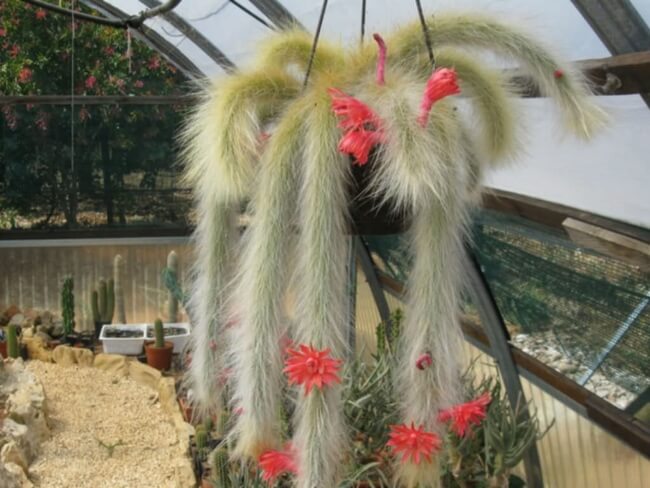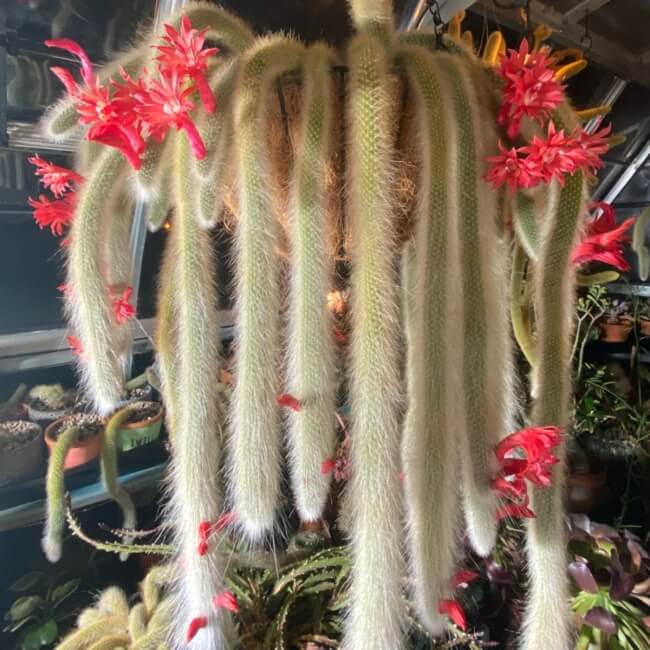Monkey tail cactus (Cleistocactus colademononis) is one of the most unusual cactuses there is. Not just because it’s trailing, but because of the way its spines form. Every characteristic of this stunning plant lends itself perfectly to its common name; Monkey tail cactus.
Don’t get too comfortable with its fluffy appearance though. If you brush against it the wrong way, it’ll take hours to get those spines out from under your skin. If you can avoid that temptation, here’s our complete guide to growing, caring for, and even propagating these fascinatingly unusual cactuses.
More...

Source: Town & Country Balwyn
Family: | Cactaceae |
|---|---|
Genus: | Cleistocactus |
Species: | C. colademononis (various others) |
Origin: | Bolivia and South America |
Common Names: | Monkey Tail Cactus |
Location: | Indoor (outdoors through summer) |
Type: | Cactus |
Growth: | Trailing up to 6 ft |
Sun requirements: | Bright light, some direct sun |
Foliage Colour: | Grey-green |
Flower Colour: | Pink, peach, red |
Flowering: | Early spring (sporadic indoors) |
Edible Parts: | None |
Maintenance level: | Medium |
Poisonous for pets: | Toxic to cats and dogs |
What is a Monkey Tail Cactus?

Source: GardenTags
Monkey Tail or Monkey’s Tail Cactus is the common name for Cleistocactus colademononis. Cleisto, from the Greek ‘kleistos’, which means ‘closed’, and colademononis, directly translates from the Spanish ‘Cola de Mono’, meaning Monkey’s Tail.
The name gives you pretty much everything you need to know about these cactuses. They have long, dangling, fluffy-looking phylloclades (stems) that grow in sequence from the base of the plant, giving the appearance of a mass of tangled monkey tails. The flowers open, but for short periods, and need manual pollination if grown indoors.
Natural Habitat of Cleistocactus colademononis
Monkey tail cactus is native to Bolivia and warmer parts of South America, where it grows fully exposed in the desert, spending most of its year in dormancy, using reserves of water to support photosynthesis.
In our homes, it needs good drainage, and as much bright light as it can get, without being exposed to direct midday sun.
They can go for months without rainfall, but are at their happiest indoors if they get a good drink about once a month through summer. Over winter, thanks to cooler indoor temperatures, avoid watering altogether unless the cactus is showing clear signs of growth.
Types of Monkey Tail Cactus
Monkey tail cactus is a unique species of cactus without cultivars or variation, but there are many similar cacti with trailing stems, and furry spines. Most notably the rat tail cactus, which has short firm spines, but a similarly trailing habit. The monkey tail cactus has distinctly soft spines.
How to Grow Monkey Tail Cactus
Growing monkey tail cactus isn’t hard, but as with any succulent, you do need to keep your eyes peeled for signs of overwatering and under-watering. Getting the soil right, and finding the right frequency for watering are key to a happy monkey tail cactus.

Monkey Tail Cactus Soil & Drainage
Monkey tail cactus is a desert plant, used to free-draining soils, long droughts, and fairly infertile growing conditions. In nature, they are slow growing because of this, but at home you can perk things up a little.
Start with any store-bought cactus potting mix, or make your own with a blend of perlite, fine orchid bark, sharp sand and soil. Once mixed it should feel like a crumbly oat cookie mix. If you add water it should just about hold together without becoming saturated.
Water Requirements
Cactuses store water in their stems over long periods of dormancy, but that doesn’t mean they don’t need watering. For the best growth, and strongest stems, water roughly once every 10-14 days.


Get Your Free Guide:
Master Growing Australian Natives eBook
A Must Have Complete Guide for Every Australian Garden
Get Your Free Guide:
Master Growing Australian Natives eBook
A Must Have Complete Guide for Every Australian Garden
If the soil is still damp from the last watering, leave it alone until it dries out. If you find yourself having to water more frequently, move your monkey tail cactus to a slightly more shaded spot.
Where to Place Monkey Tail Cactus
Monkey tail cactus prefers indirect bright light, but it does cope in full sun if you only have a windowsill for it to live on. As long as you manage and maintain its water routine properly, and start with a decent potting mix for cactuses, it’s an incredibly resilient plant that will cope in any Australian home.
Growing Monkey Tail Cactus Indoors Vs Outdoors
Monkey tail cactus can be grown indoors or outdoors providing winter temperatures don’t drop below about 10°C. In both cases they should be elevated above ground level to prevent their stems being sat on damp soil, or surfaces that can trap moisture. That means that the best container for monkey tail cactus is either a hanging basket or a pot on an elevated shelf.
Monkey tail cactuses will grow towards the light, so if you place it on a shelf indoors, it will grow heavily on one side, and become bare on the other. Hanging baskets allow you to rotate the plants, without restricting growth.
Growing monkey tail cactus outdoors gives better access to light, and even in colder parts of the country, you can simply bring them indoors for winter.
How to Propagate Monkey Tail Cactus
You can propagate monkey tail cactus from seed, but it’s unlikely you’ll get any flowers from your indoor cactus. There are plenty of places online that sell cactus seeds, but if you’ve already got one, or know a generous friend with a monkey tail cactus, cuttings are the most reliable form of propagation.

Source: Citycacti
Monkey Tail Cactus Propagation from Cuttings
Like all cacti, monkey tail cactus roots beautifully from stem cuttings (technically phylloclades, not stems, but let’s not split hairs). All they need is light moisture and a potting mix that’s easy to root into. The real trick is patience, and trusting that there’s enough water stored for the time needed to callous.
To take monkey tail cactus cuttings you will need:
- Tissue
- Cactus potting mix (or a DIY mix)
- Plastic pot
- Mister
- Heated propagator (optional)
- A monkey tail cactus
Once you’ve gathered your materials, taking the cutting is relatively quick and incredibly simple. Follow the method below for best results, and water the day before to plump up stems before cutting.
- In spring or summer (the active growing season) snap a section of stem off where it joins another. There will be dips and joins quite clearly when this is possible. Avoid using scissors as you’ll damage the original plant, and cuttings are less reliable.
- Place the section of monkey tail cactus onto some tissue for 2-3 days, making sure to mark the severed end.
- Once it has calloused over (preventing infection and rot) fill a small plastic pot with cactus mix, and dib a hole slightly larger than the end of the cutting.
- Place the calloused end of your monkey tail cactus cutting into the compost, and water lightly.
- Place it somewhere bright, but away from direct sunlight.
- Mist daily to prevent it from drying out, and water if the soil dries out.
- Within about two weeks, the cutting should have rooted, but leave it in this pot until roots show from the base.
Note: Another method is to simply lay the cutting on the surface of fresh compost, where it can callous over, and then be watered lightly or misted. This method works well, but requires more attention.
How to Care for Monkey Tail Cactus
Monkey tail cactus don't need much care, but like nearly all houseplants, what you see in your home isn’t even close to how they grow in nature.
Most houseplants, cacti in particular, are designed to withstand the extremes of their own climates. For cacti, that’s more extreme than most. In nature, they can dry up and look incredibly gaunt, and no one minds if they grow at a snail’s pace.
In our homes, keeping them growing right through the season, and looking green even through winter, can be tricky, but with some added fertilisers, and semi-regular repotting, your monkey tail cactus will thrive.
Monkey Tail Cactus Fertiliser
Feed monkey tail cactus with any cactus fertiliser. They are all based on a simple low-nitrogen, high-potassium mix to encourage general growth. Be sparing. If you have one cactus at home, a bottle of cactus fertiliser should last for several years.
Pruning Needs
Unless your monkey tail cactus has notable damage, either from pests or disease, there’s no benefit to the plant in pruning it.
Repotting Monkey Tail Cactus
Any shop bought cactus fertiliser will suffice for monkey tail cactus, but shouldn’t replace the need for repotting. There are so many gardeners who rely on fertilisers over proper care to top up nutrients, when what plants actually want is more space, and new compost.
Because indoor monkey tails grow about three times faster than their wild ancestors (regular watering, more stable conditions, and less dormancy are key to this), their shallow roots do benefit from an increase in pot size at least once every four or five years.
Monkey Tail Cactus Pests and Diseases
Cactuses callous over incredibly well, so pest damage isn’t a big problem, but it can be if you have other houseplants. Essentially, mealybugs, aphids, scale insects, etc., all adore cacti, because they provide sustainable food for them, without rotting away after being bitten.
Because of that, they can infest other plants easily. Prevent most of these infestations with proper watering. For example, mealy bugs don’t like dry soil, and your cactus should be allowed to dry out before watering.
Over-watering, and under-watering can both cause crown rot or root rot, which creates noticeably weak connections between stem sections, and at the base of the plant, with a puckered skin.
If the soil is wet, but this is happening, dry the plant out for a week or so, before changing its soil. If it’s dry, place the pot in a tray of water until the soil is saturated, and then leave it to recover.
Monkey Tail Cactus Frequently Asked Questions

How do you take care of monkey tail cactus in winter?
Monkey tail cactus enjoy dormant winters. It might seem harsh, but even if your indoor temperatures remain at good levels for growth, the shorter days mean the cactus will quite happily go right through autumn and winter without a drop of water. Saturate the soil in spring to trigger new growth.
Do monkey tail cactus grow pups?
Monkey tail cactus grow pups in two ways. They can be found around the base of the plant, sometimes with separate root systems, and from the ends of the ‘tails’. Both make excellent cutting material.
How big can monkey tail cactus get?
The biggest monkey tail cactus I’ve ever seen was about 4 ft long, with a dense mass of stems around the base, but they can actually reach 6ft in ideal conditions.
How fast growing is monkey tail cactus?
Monkey tail cactus is a particularly fast-growing cactus, reaching maturity in about 15 years, but with individually mature stems in as little as 6 years. Mature stems can be about 7 cm in diameter.
Wrapping Up Our Guide to Growing Monkey Tail Cactus in Australia
No cacti collection is even close to complete without a monkey tail cactus (Cleistocactus colademononis). There’s just nothing else like them. Even if you’ve never grown houseplants before, this simple to care for cactus is a beautiful addition to living spaces, and is sure to get any visitors excited.
The monkey tail plant is perfect for anyone without a green thumb, and responds wonderfully to anyone with a bit more confidence. As you get to know monkey tail cactus, they mature, and develop characteristics of their own, and are definitely worth a spot on your shelf.
Published on October 1, 2023 by Maisie Blevins
Last Updated on October 18, 2024




